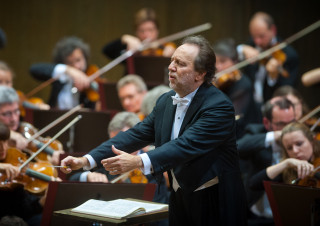|
Back
Majestic, Magnificent Mendelssohn from the Source Houston
Jones Hall
11/03/2014 - & November 8, 2014 (Newark)
Felix Mendelssohn: The Hebrides, Op. 26 – Violin Concerto in E Minor, Op. 64 – Symphony No. 5 in D Major, Op. 107 ("Reformation")
Nikolaj Znaider (violin), Gewandhausorchester Leipzig, Riccardo Chailly (conductor) 
R. Chailly (© Gert Mothes)
This concert was a true happening. German and American dignitaries, including former president George H.W. Bush, convened in Houston's Jones Hall to commemorate the 25th anniversary of the fall of the Berlin Wall. A visit by an orchestra of this stature, not to mention a conductor of Riccardo Chailly's ability and renown, is sadly a rarity in Houston. It was a pity that the seats were not packed, but by the end of the program, it was clear to everyone present that they had experienced a unique musical event.
Mendelssohn's music is the Gewandhaus Orchestra's bread and butter, and the organicism of the performances of all three works was incredible. Even before the first downbeat of The Hebrides, one anticipated a different sound from the ensemble based on stage orientation. Split violins, double basses to the audience's left and cellos facing straight ahead, horns seated with the woodwinds, and timpani high in the center back, the orchestra was compact on stage, an extended chamber ensemble instead of a conglomeration of separate instrumental families. As the music progressed, the individual players moved together as if carefully choreographed, each anticipating and reacting to one another like clockwork.
The open fifth that kicks off the Scottish soundscape laid the foundation for a dark, detailed rendition. Mendelssohn's orchestration demands spot-on rhythmic execution, and a universal, internalized subdivision was apparent as motives were passed seamlessly from section to section. Chailly stirred up an appropriate tempest before the recapitulation, where the flutes spout chromatic sea spray upwards, after which the energy subsided into a sublime clarinet solo at the second theme. This was refinement through and through, a memorable performance that matches any on disc.

N. Znaider (© George Lange)
Nikolaj Znaider channeled Heifetz in the outer movements of the Violin Concerto. Here was sparkling, energetic playing, taken at breakneck speeds. There were a few moments were soloist-orchestra coordination threatened to become skewed, but the Gewandhaus musicians almost immediately autocorrected and snapped right back in line. Znaider's generous vibrato made for a touching Andante, here switching gears to a Menuhin or Oistrakh-inspired rendition. The return of the famous melody, played at an impossible whisper that still managed to carry above the orchestra, was a soft, nostalgic climax of the performance. Woodwinds in the finale were especially fine, effortlessly weaving their figurations in and out of Znaider's passagework.
The inclusion of Mendelssohn's second symphonic essay (numbered the fifth upon its posthumous publication) was a pleasant surprise. The the "Scottish" and "Italian" symphonies turn up more frequently is likely due to the slightly stodgy academic exercise of the "Reformation's" finale. The forthright first and charming second movements were again spot on in execution and interpretation, but the most exquisite moment of the entire concert came at the opening of the third movement. Here, the first violin's dolce melody emerged with gorgeous phrasing and rhythmic precision, floating ethereally above the lower strings. This led to the linking flute solo, given a wonderful performance, before Mendelssohn's contrapuntal rifts on "Ein feste Burg ist unser Gott!" began. The polyphonic passagework was always clear, and the entry of the trombones, contrabassoon and ophicleide added heft to the exciting closing moments.
Chailly and his orchestra rewarded the Houston audience's thunderous ovation with two selections from A Midsummer Night's Dream, the "Intermezzo" again showing off the orchestra's inimitable ability to balance and trade motives, the "Wedding March" coaxing audible nods of familiarity from the audience and rousing another standing ovation. This was fabulous music-making and an excellent, much-needed good dose of a different style of orchestral musicianship than one typically hears in Houston. It is hoped that events like these won't be reserved for important historical anniversaries, but will become a regular part of future seasons in Houston.
Marcus Karl Maroney
|